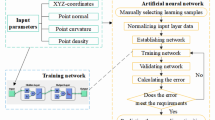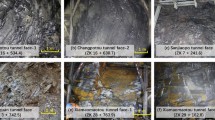Abstract
Accurately obtaining rock mass discontinuity information holds particular significance for slope stability analysis and rock mass classification. Currently, non-contact measurement methods have increasingly become a supplementary means to traditional techniques, especially in hazardous and inaccessible areas. This study introduces an innovative semi-automatic method to identify discontinuities from point clouds. A modified convolutional neural network, AlexNet, was established to identify discontinuity sets. The network consists of five convolutional layers and three fully connected layers, utilizing 1 × 3 normal vectors computed by K-nearest neighbor and principal component analysis as input and generating an output value “i” that represents the identified discontinuity set associated with the “i” category. Learning samples for network training were randomly selected from point clouds and automatically categorized using the improved fuzzy C-means (FCM) based on particle swarm optimization (PSO). The orientations of individual discontinuities, identified from the discontinuity set using hierarchical density–based spatial clustering of applications with noise, were calculated. Two outcrop cases were employed to validate the efficacy of the proposed method, and parameter analysis was conducted to determine optimal parameters. The results demonstrated the reliability of the method and highlighted improvements in automation and computational efficiency.




















Similar content being viewed by others
Data Availability
The data that support the findings of this study are available from the corresponding author, Bei Cao, upon reasonable request.
Code availability
The codes that support the findings of this study are available at GitHub (https://github.com/rockslopeworking/Rockmass-discontinuity).
References
Buyer A, Schubert W (2017) Calculation the spacing of discontinuities from 3D point clouds. Procedia Eng 191:270–278
Campello RJ, Moulavi D, Sander J (2013) Density-based clustering based on hierarchical density estimates. Pacific-Asia conference on knowledge discovery and data mining. Berlin Heidelberg, Springer, Berlin Heidelberg, pp 160–172
Chen J, Zhu H, Li X (2016) Automatic extraction of discontinuity orientation from rock mass surface 3D point cloud. Comput Geosci 95:18–31
Chen N, Kemeny J, Jiang Q, Pan Z (2017) Automatic extraction of blocks from 3D point clouds of fractured rock. Comput Geosci 109:149–161
Chigira M (1992) Long-term gravitational deformation of rocks by mass rock creep. Eng Geol 32(3):157–184
Cui X, Yan EC (2020) A clustering algorithm based on differential evolution for the identification of rock discontinuity sets. Int J Rock Mech Min Sci 126:104181
Daghigh H, Tannant DD, Daghigh V, Lichti DD, Lindenbergh R (2022) A critical review of discontinuity plane extraction from 3D point cloud data of rock mass surfaces. Comput Geosci 169:105241
Ester M, Kriegel HP, Sander J, Xu X (1996) A density-based algorithm for discovering clusters in large spatial databases with noise. In Kdd 95:226–231
Ferrero AM, Forlani G, Roncella R, Voyat HI (2009) Advanced geostructural survey methods applied to rock mass characterization. Rock Mech Rock Eng 42:631–665
Fischler MA, Bolles RC (1981) Random sample consensus: a paradigm for model fitting with applications to image analysis and automated cartography. Commun ACM 24(6):381–395
Ge Y, Xia D, Tang H, Zhao B, Wang L, Chen Y (2017) Intellectual identification and geometric properties extraction of rock discontinuities based on terrestrial laser scanning. Rock Mech Eng 36(12):3050–3061
Ge Y, Tang H, Xia D, Wang L, Zhao B, Teaway JW, Zhou T (2018) Automated measurements of discontinuity geometric properties from a 3D-point cloud based on a modified region growing algorithm. Eng Geol 242:44–54
Ge Y, Cao B, Tang H (2022) Rock discontinuities identification from 3D point clouds using artificial neural network. Rock Mech Rock Eng 55(3):1705–1720
Gigli G, Casagli N (2011) Semi-automatic extraction of rock mass structural data from high resolution LIDAR point clouds. Int J Rock Mech Min Sci 48(2):187–198
Gischig V, Amann F, Moore JR, Loew S, Eisenbeiss H, Stempfhuber W (2011) Composite rock slope kinematics at the current Randa instability, Switzerland, based on remote sensing and numerical modeling. Eng Geol 118(1–2):37–53
Guo J, Liu S, Zhang P, Wu L, Zhou W, Yu Y (2017) Towards semi-automatic rock mass discontinuity orientation and set analysis from 3D point clouds. Comput Geosci 103:164–172
Han X, Yang S, Zhou F, Wang J, Zhou D (2017) An effective approach for rock mass discontinuity extraction based on terrestrial LiDAR scanning 3D point clouds. Ieee Access 5:26734–26742
Han G, Zhang C, Singh HK, Huang S, Zhou H, Gao Y (2023) A comprehensive investigation of engineering geological characteristics of interlayer shear weakness zones embedded within Baihetan hydropower station. Tunn Undergr Space Technol 132:104891
Hu L, Xiao J, Wang Y (2020) Efficient and automatic plane detection approach for 3-D rock mass point clouds. Multimed Tools Appl 79:839–864
Jaboyedoff M, Metzger R, Oppikofer T, Couture R, Derron MH, Locat J, Turmel D (2007) New insight techniques to analyze rock-slope relief using DEM and 3D imaging cloud points: COLTOP-3D software. In: ARMA Canada-US rock mechanics symposium, Vancouver, ARMA-07
Kennedy J, Eberhart R (1995) Particle swarm optimization. In: Proceedings of ICNN'95-international conference on neural networks, Perth, pp 1942–1948
Kong D, Wu F, Saroglou C (2020) Automatic identification and characterization of discontinuities in rock masses from 3D point clouds. Eng Geol 265:105442
Krizhevsky A, Sutskever I, Hinton GE (2012) Imagenet classification with deep convolutional neural networks. In: Advances in neural information processing systems 25. Lake Tahoe, pp 1097–1105
Lato MJ, Vöge M (2012) Automated mapping of rock discontinuities in 3D lidar and photogrammetry models. Int J Rock Mech Min Sci 54:150–158
Lato M, Diederichs MS, Hutchinson DJ, Harrap R (2009) Optimization of LiDAR scanning and processing for automated structural evaluation of discontinuities in rockmasses. Int J Rock Mech Min Sci 46(1):194–199
Lato M, Kemeny J, Harrap RM, Bevan G (2013) Rock bench: Establishing a common repository and standards for assessing rockmass characteristics using LiDAR and photogrammetry. Comput Geosci 50:106–114. https://doi.org/10.1016/j.cageo.2012.06.014
Leng X, Xiao J, Wang Y (2016) A multi-scale plane-detection method based on the Hough transform and region growing. Photogram Rec 31(154):166–192
Li Y, Wang Q, Chen J, Xu L, Song S (2015) K-means algorithm based on particle swarm optimization for the identification of rock discontinuity sets. Rock Mech Rock Eng 48:375–385
Li X, Chen Z, Chen J, Zhu H (2019) Automatic characterization of rock mass discontinuities using 3D point clouds. Eng Geol 259:105131
Ma G, Hu X, Yin Y, Luo G, Pan Y (2018) Failure mechanisms and development of catastrophic rockslides triggered by precipitation and open-pit mining in Emei, Sichuan, China. Landslides 15:1401–1414
Mah J, Samson C, McKinnon SD, Thibodeau D (2013) 3D laser imaging for surface roughness analysis. Int J Rock Mech Min Sci 58:111–117
McInnes L, Healy J (2017) Accelerated hierarchical density based clustering. In: 2017 IEEE international conference on data mining workshops (ICDMW), New Orleans, pp 33–42
Menegoni N, Giordan D, Perotti C, Tannant DD (2019) Detection and geometric characterization of rock mass discontinuities using a 3D high-resolution digital outcrop model generated from RPAS imagery–Ormea rock slope, Italy. Eng Geol 252:145–163
Otoo JN, Maerz NH, DuanY, Xiaoling L (2011) LiDAR and optical imaging for 3-D fracture orientations. In: Proceedings of the 2011 NSF engineering research and innovation conference. Atlanta
Park J, Cho YK (2022) Point cloud information modeling: Deep learning–based automated information modeling framework for point cloud data. J Constr Eng Manag 148(2):04021191
Pauly M, Gross M, Kobbelt LP (2002) Efficient simplification of point-sampled surfaces. In: IEEE visualization 2002. VIS 2002, Boston, pp 163–170
Riquelme AJ, Abellán A, Tomás R, Jaboyedoff M (2014) A new approach for semi-automatic rock mass joints recognition from 3D point clouds. Comput Geosci 68:38–52
Riquelme AJ, Tomás R, Abellán A (2016) Characterization of rock slopes through slope mass rating using 3D point clouds. Int J Rock Mech Min Sci 84:165–176
Riquelme A, Tomás R, Cano M, Pastor JL, Abellán A (2018) Automatic mapping of discontinuity persistence on rock masses using 3D point clouds. Rock Mech Rock Eng 51:3005–3028
Rodriguez A, Laio A (2014) Clustering by fast search and find of density peaks. Science 344(6191):1492–1496
Singh SK, Raval S, Banerjee BP (2021) Automated structural discontinuity mapping in a rock face occluded by vegetation using mobile laser scanning. Eng Geol 285:106040
Slob S, Hack R, Turner AK (2002) An approach to automate discontinuity measurements of rock faces using laser scanning techniques. In: ISRM international symposium - EUROCK 2002, Madeira, Portugal, Paper Number: ISRM-EUROCK-2002-006
Slob S (2010) Automated rock mass characterisation using 3-D terrestrial laser scanning. Dissertation, Technische Universiteit Delft, Deltf
Song S, Wang Q, Chen J, Li Y, Zhang W, Ruan Y (2017) Fuzzy C-means clustering analysis based on quantum particle swarm optimization algorithm for the grouping of rock discontinuity sets. KSCE J Civ Eng 21(4):1115–1122
Sun W, Wang J, Yang Y, Jin F (2021) Rock mass discontinuity extraction method based on multiresolution supervoxel segmentation of point cloud. IEEE J Sel Top Appl Earth Obs Remote Sens 14:8436–8446
Van Knapen B, Slob S (2006) Identification and characterisation of rock mass discontinuity sets using 3D laser scanning. Procedia Eng 191:838–845
Vasuki Y, Holden EJ, Kovesi P, Micklethwaite S (2014) Semi-automatic mapping of geological Structures using UAV-based photogrammetric data: an image analysis approach. Comput Geosci 69:22–32
Vöge M, Lato MJ, Diederichs MS (2013) Automated rockmass discontinuity mapping from 3-dimensional surface data. Eng Geol 164:155–162
Wang X, Zou L, Shen X, Ren Y, Qin Y (2017) A region-growing approach for automatic outcrop fracture extraction from a three-dimensional point cloud. Comput Geosci 99:100–106
Wu X, Wang F, Wang M, Zhang X, Wang Q, Zhang S (2021) A new method for automatic extraction and analysis of discontinuities based on TIN on rock mass surfaces. Remote Sens 13(15):2894
Yang S, Liu S, Zhang N, Li G, Zhang J (2021) A fully automatic-image-based approach to quantifying the geological strength index of underground rock mass. Int J Rock Mech Min Sci 140:104585
Yi X, Feng W, Wang D, Yang R, Hu Y, Zhou Y (2023) An efficient method for extracting and clustering rock mass discontinuities from 3D point clouds. Acta Geotech 18:3485–3503
Zhang P, Du K, Tannant DD, Zhu H, Zheng W (2018) Automated method for extracting and analysing the rock discontinuities from point clouds based on digital surface model of rock mass. Eng Geol 239:109–118
Zhang Y, Yue P, Zhang G, Guan T, Lv M, Zhong D (2019) Augmented reality mapping of rock mass discontinuities and rockfall susceptibility based on unmanned aerial vehicle photogrammetry. Remote Sens 11(11):1311
Acknowledgements
Thanks to Dr. Siefko Slob for sharing the point clouds of case A. The raw data of case B was obtained from the Rockbench repository. The authors kindly appreciated M. Lato, J. Kemeny, R.M. Harrap, and G. Bevan for establishing the Rockbench repository. The authors’ special appreciation goes to editors and anonymous reviewers for valuable comments.
Funding
This work was supported by the National Natural Science Foundation of China (No. 41974148), the Natural Resources Science and Technology Project of Hunan Province (Grant No.2022–01), the Research Foundation of the Department of Natural Resources of Hunan Province (Grant No. 20230101DZ), and the Science and Technology Research and Development Project of China Railway Co., LTD (No. 2022-Special-07).
Author information
Authors and Affiliations
Contributions
Conceptualization: Guangyin Lu, Bei Cao; methodology: Guangyin Lu, Bei Cao; formal analysis: Guangyin Lu, Zishan Lin; investigation: Bei Cao, Xudong Zhu; writing—original draft: Bei Cao; writing—review and editing: Bei Cao, Xudong Zhu, Zishan Lin, Chuanyi Tao, Yani Li; data curation: Bei Cao, Xudong Zhu; visualization: Guangyin Lu, Xudong Zhu; software: Bei Cao, Xudong Zhu; validation: Xudong Zhu, Zishan Lin, Dongxin Bai, Chuanyi Tao; funding acquisition: Guangyin Lu; resources: Guangyin Lu; supervision: Dongxin Bai, Yani Li;
Corresponding author
Ethics declarations
Competing interests
The authors declare no competing interests.
Rights and permissions
About this article
Cite this article
Lu, G., Cao, B., Zhu, X. et al. Identification of rock mass discontinuity from 3D point clouds using improved fuzzy C-means and convolutional neural network. Bull Eng Geol Environ 83, 159 (2024). https://doi.org/10.1007/s10064-024-03658-1
Received:
Accepted:
Published:
DOI: https://doi.org/10.1007/s10064-024-03658-1




